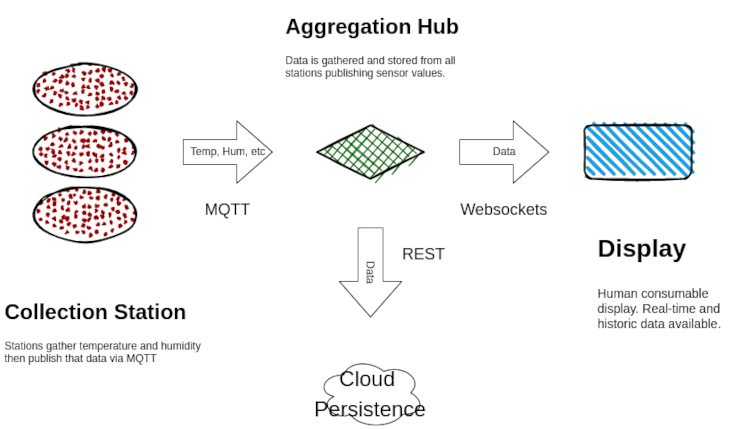
What is this project about?
Organic Gardner (OG) is an automated irrigation system that gathers soil moisture levels from various sections of a garden then uses that data to activate the garden sprinkler system. Done right, this will eliminate both over and under watering. Likewise there will no longer be any need to program the watering schedule with confusing sprinkler menus.
Although she does not know it yet, my wife will volunteer her succulent garden for testing!
From this hopefully interesting and useful example project we will establish a set of Best Practices and software that will help reduce the complexity and time to market with your IoT software project.
What Makes IoT Software Different?
An IoT project usually involves taking a physical device (or functional system) like a doorbell (Ring) or Heater (Nest) and adding smart software with an Internet connection to open a whole new world of services.
The Ring Doorbell is a popular example of an IoT enhanced product. It allows you to see and talk to somebody on your porch when you are a thousand miles away or in your bathroom.
The Nest thermometer learns exactly what temperature you want your house, it then keeps your home exactly the temperature you want. Even better, when your not home it will not waste any energy.
Just applying smarts to reduce energy consumed in widely used applications alone is an worthy avenue to pursuit
IoT Brings New Challenges
With all the great new capabilities IoT software brings with it today, these same benefits also bring bring a heavy cost of complexity. The key to beating the complexity and efficiently building robust software is to embrace the right processes, a major goal of this website.
Establishing Best Practices
By establishing the right Software Development Processes for your project based on Best Practices gathered on this website we can work together to reduce complexity and build software that is more simple, robust and reusable.
The Development Plan
To avoid being overwhelmed with details and keep the project moving
forward we will build it out incrementally, one interesting feature at
a time stacking cool feature on top of cool feature. Testing will be
performed initially by mocking the collection station MQTT
publishers with the mosquito_pub command line tool.
Let’s steal the term from Lean Startup and define our MVP by etching out the details of our developmental milestones.
MVP Milestones
The milestones are defined such that upon the completion of each one we incrementally adds useful features to the application until we iterate toward the complete OG MVP.
1
Hub Subscribes to MQTT data
This first Milestone we import the eclipse MQTT library for go and
get to collecting environmental data transmitted (mocked) using the
mosquito_pub publishing tool. The data collected is stored
efficiently in RAM for quick retrieval
2
Hub Provides REST API for Data
Now that the Hub has data efficiently stored in RAM we need a way to
access the data, for that we'll create a REST API. The REST API is
dependent on an HTTP server and router that can easily be provided
introducing the go net/http built-in package.
3
Dashboard Displays Historic Data
The next milestone is our responsive Single Page App (SPA) written with the Vue JavaScript framework. The SPA will also be served up by the Hub's HTTP server. The Dashboard will display historic data retrieved via the Hubs REST API.
4
Dashboard Displays Real Time Data
This phase of the project we add Websockets to the Hub and Dashboard allowing the Hub to stream real-time sensor data to the Dashboard. The Dashboard will always display the latest data for every sensor it displays as soon as the data arrives.
5
Collection Station Transmits Data
This is the most interesting part of the project for me. This is were we prototype hardware using the esp32 SoC and write some real time software. When this is complete we can replace the mock MQTT data with real data from a real sensor!
6
Introducing the Cloud
The final frontier, at least for this set of milestones is global connectivity through the cloud. An Internet connection will allow us to provide global access, safe persistent storage and fleet management software preparing us for the next rounds of feature releases.
The Software Components
This project reflects a “real world” software project in that it involves a variety of programming languages, protocols and technologies: Go, C++, JavaScript, HTTP, MQTT, Websockets and other stuff.
This set of articles takes more of a systems view of software application architecture, rather than a deep dive into a single programming language or technology. Make no mistake though, this content will take on some tough technical challenges and work out some important programming problems in detail.
The Process of Software Development
A heavy emphasis of this site will be on the software development processes, often referred to as the Software Development Life cycle. We will cover topics like: Agile, Kan ban, Test Driven Development, Version Control and the release processes (CI/CD).
This information will be particularly important for product owners and managers responsible for building a team that will deliver software.
Software Component Overview
The project at this point consists of the following primary software components. Each of these components are operational and Open Source with a Github Repo. Instructions to build and run each component can be found on the respective README.md file.
If you are interested in getting involved in a specific software component and related technology, head to that software component to see what is going on and get involved!